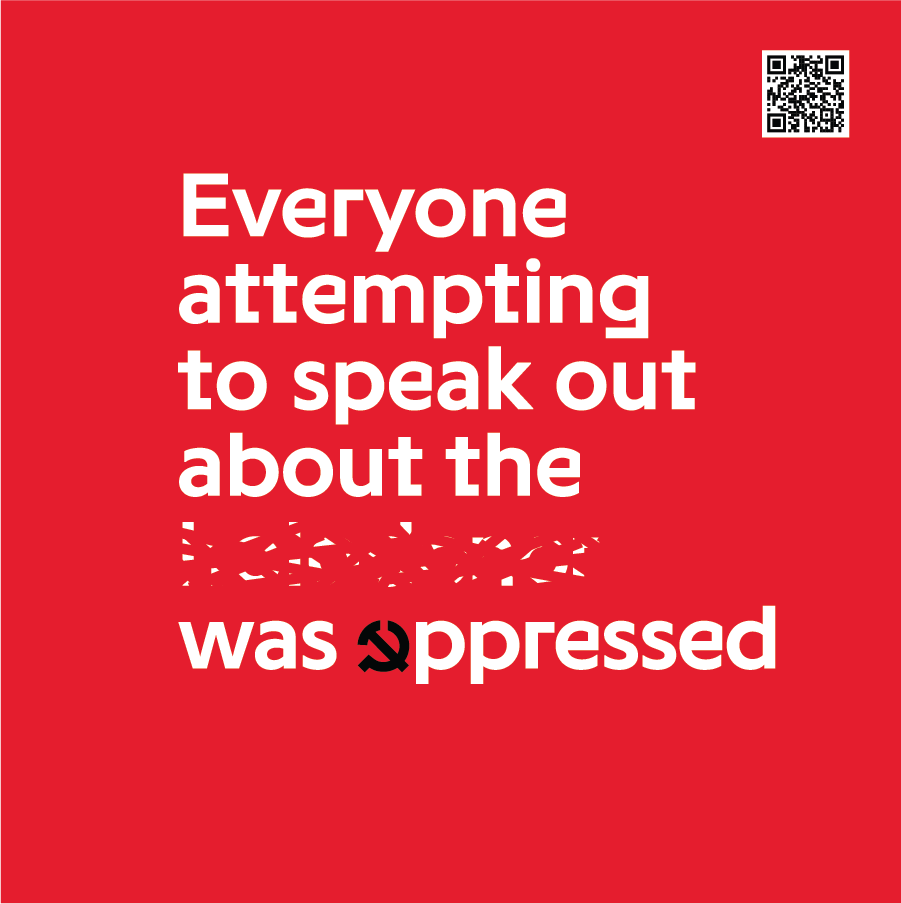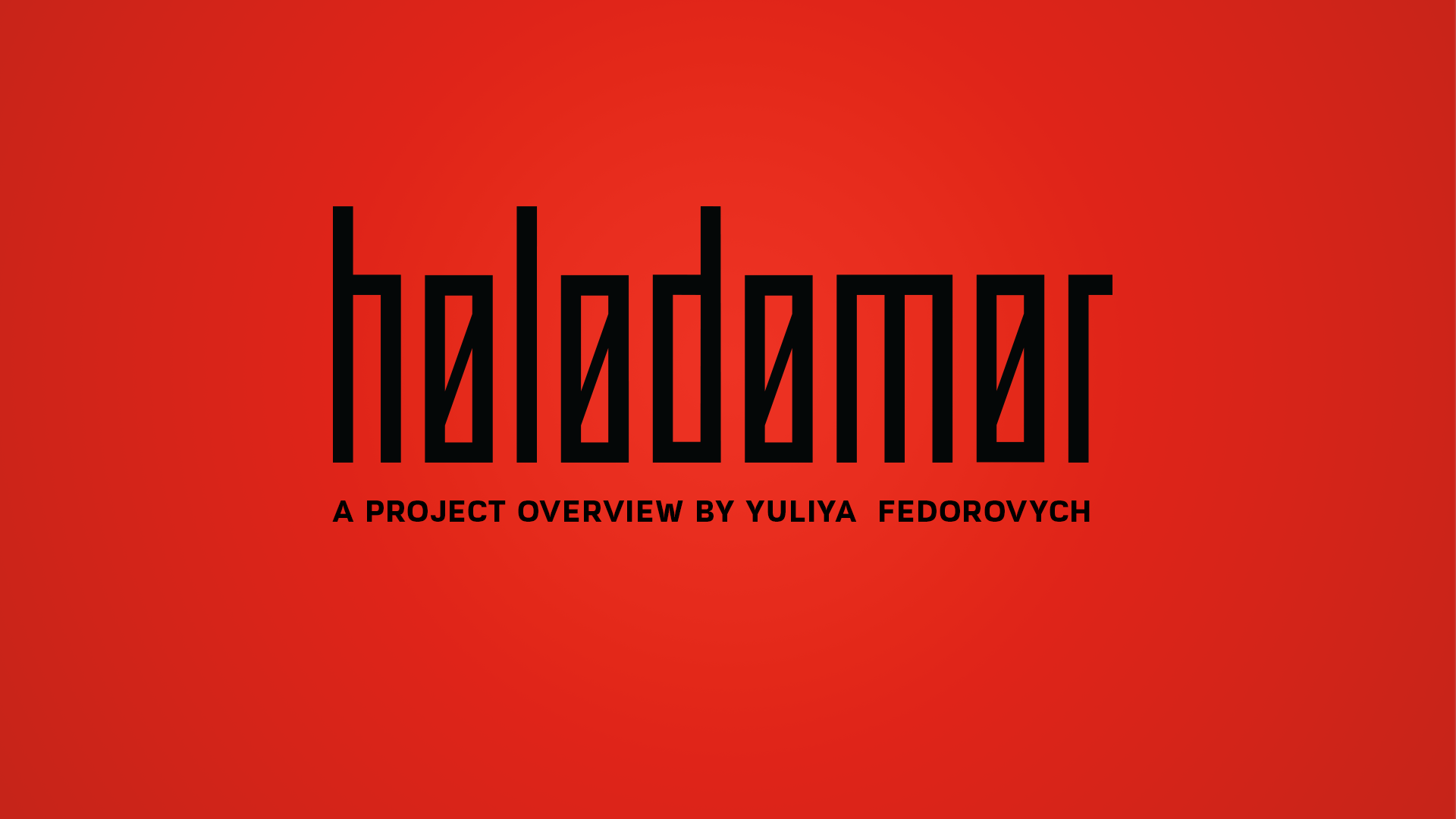
HØLØDØMØR: an augmented reality poster series promoting genocide awareness
Holodomor is a Ukrainian word meaning to kill by starvation. From 1932 to 1933, the Soviet Union, led by Stalin, orchestrated a genocide that killed millions of Ukrainians. For decades, the Soviets hid this crime by isolating their occupied territories from the rest of the world, spreading propaganda, and intimidating witnesses. Soviets, and subsequently Russians, have always denied the fact of this genocide, and no one was ever punished for these crimes. This impunity likely became a key factor enabling Russia to occupy a significant part of Ukrainian territory in 2014 and to start a full-scale invasion in February 2022. Only by exposing these crimes can we prevent future genocides.
My research suggests that Western audiences are largely unaware of the Holodomor due to the Soviet Union’s concerted efforts to conceal it. Therefore, I created HØLØDØMØR, a poster series aimed at educating people about the history and consequences of this genocide, which took the lives of millions. This project uses a universally understood pictographic language alongside augmented reality tools that help bring the visuals to life.

REsearch & EXPLORATIONVisualizing atrocities as informed by extensive research
I carried out extensive research, immersing myself in the history of the Holodomor and learning about the perpetrators, victims, and modern-day scholarship surrounding this genocide. I examined the level of genocide awareness among Western audiences and investigated how the period and region are represented in Western primary and secondary educational materials and common reference sources.
I found that Western audiences are largely unaware of the Holodomor, likely due to Soviet efforts to conceal their crimes from the world. Many modern Western educational materials refer to the Soviet Union as an ally of the West during the Second World War and to Stalin as a “necessary evil”. One of the Western audiences' primary points of reference for this period is Soviet constructivist propaganda posters, a style that has been widely used in the media and advertising. Western audiences are also familiar with the Soviet symbols as well as some of the major historical figures from that period. However, they are largely unaware of other historical figures tied to the Holodomor, including Westerners who worked alongside the Soviets for personal gain. Shockingly, some Westerners even have positive perceptions of Stalin and the USSR.
I wanted to create a project that educated Western audiences about the true history of the period and the Holodomor. I explored concepts that tap into and build upon Western audiences' preexisting knowledge of the period using the color palette and typography of constructivist posters. I also explored incorporating the patterns and styles of traditional Ukrainian embroidery.

Concept 1.
Exposing the Perpetrators
Soviet leaders orchestrated the Holodomor to quash political dissent in Ukraine. Joseph Stalin ordered the genocide, Genrikh Yagoda led the mass arrests and executions, and Walter Duranty spread propaganda denying the famine in the pages of The New York Times. This concept aims to educate people and build awareness by exposing these criminals who were never held responsible for their crimes.
Concept 2.
Building Awareness
The word “Holodomor” does not appear in most American dictionaries, which speaks to the low level of awareness about it among Western audiences. This concept aims to educate Western viewers by defining the word “Holodomor,” grounding the scope of the tragedy in the context and visually explaining it to the viewer.
Concept 3.
Overwhelming Facts
The events of the Holodomor present a stark contrast to the modern Western lifestyle. They are also unimaginable from a human rights perspective. This concept presents facts about the crimes of the Holodomor in juxtaposition to the context and invites the viewer to learn more.
Concept 4.
Highlighting the Truth
Walter Duranty, a Pulitzer Prize recipient, lied about the Holodomor. At the peak of the famine, The New York Times published a series of his articles denying the famine and stating that “the people are well nourished.” This concept aims to expose these lies by retrospectively highlighting the truth.
Concept 5.
Erased from History
This concept erases portions of images and facts about the Holodomor to build intrigue and invite the viewer to learn more. The USSR intimidated witnesses, spread propaganda, and hid its crimes behind the Iron Curtain. They tried to erase the Holodomor from history, and few photographs exist from that time. Those that do exist are either official Soviet propaganda or images of the famine taken secretly and smuggled out of the country. As a result, the Holodomor remains unknown among Western audiences and is unmentioned in many history textbooks.

solutionHØLØDØMØR: Unmasking a Hidden Genocide through Design and Augmented Reality
My design solution consists of ten posters with short captions that guide the audience through the events of the Holodomor and explain its consequences. Each poster is interactive and accompanied by augmented reality. When viewers hover their phones over the posters, an animation starts to tell the story behind the visuals through motion and sound.
The name of this project, HØLØDØMØR, with all the letters O crossed out, symbolically depicts the death rate of Ukrainians during this genocide famine. It is unlikely we will ever know the exact number of victims, but on the order of millions died from starvation.
HØLØDØMØR uses a visual language that reclaims the style of Soviet propaganda posters from the period. This style is often thoughtlessly used in Western media, culture, advertising, and daily life. HØLØDØMØR recontextualizes the typography and color palette of soviet propaganda posters to expose the crimes they intended to hide. This approach builds a visual link to the audience's preexisting knowledge of the period. The visual language of HØLØDØMØR is also strongly aligned with the cultural heritage of Ukraine and adopts the distinctive patterns and styles of Ukrainian embroidery.
HØLØDØMØR Presentations & Expositions
-
National Museum of the Holodomor-Genocide
Kyiv, Ukraine, 2023National Library of Ukraine for Children
Kyiv, Ukraine, 2023Museum of Ostroh Academy
Ostroh, Rivne Oblast, Ukraine, 2023 and 2024 -
The Ukrainian Cultural and Educational Centre – Oseredok
Winnipeg, Manitoba, 2024Carleton University
Ottawa, Ontario, 2024University of Ottawa, Ottawa, Canada
Ottawa, Ontario, 2022 -
Boston City Hall
Boston, Massachusetts, 2024University of Notre Dame (permanent installation)
South Bend, Indiana, 2020 -
Johannesburg Holocaust and Genocide Memorial
Johannesburg, South Africa, Apr 2025 – May 2025
Cape Town Holocaust & Genocide Centre
Cape Town, South Africa, 2023Durban Holocaust & Genocide Centre
Durban, South Africa, 2024 -
Tigre Town Council,
Tigre, Buenos Aires, Argentina, 2024Cafe Kyiv (Colosseum Berlin)
Berlin, Germany, 2024The Embassy of Ukraine in Georgia
Tbilisi, Georgia, 2023
Museum of the Holodomor-Genocide, Kyiv, Ukraine, 2023
University of Ottawa, 2022, Ottawa, Canada
Carleton University, Ottawa, Canada, 2024

Ostroh Academy, Ostroh, Ukraine, 2023
Cape Town Holocaust & Genocide Centre, Cape Town, South Africa, 2023

“Using purely visual graphics created for her HØLØDØMØR poster series, Yuliya Fedorovych is the first to tell the story of the 1932-33 Holodomor genocide in Ukraine using an original contemporary graphic language. Visual imagery creates a direct opening to our feelings and can be enormously useful with students in the classroom to evoke empathy when exploring historical events. In her posters and animated video storytelling, Soviet-style design elements are brought to heel and stitched to Ukrainian embroidery patterns to reclaim and uncover what the original propaganda posters tried to hide. Teachers can use these to engage students in discovering events of the Holodomor story simply by asking students what they see and how it makes them feel—a perfect visual tool to use in the classroom.”
— Sophia Isajiw, Assistant Director of Education, Holodomor Research and Education Consortium (HREC)
“Yuliya Fedorovych is extremely talented and used a different lens to understand the topic of the Holodomor. Using visual language that alludes to elements of traditional folk embroidery, she showed the history, causes, and consequences of this genocide in the broadest sense. She visually demonstrated that the magnitude of this tragedy goes beyond artificially orchestrated food shortage that led to mass starvation.”
— Lesia Hasydzhak, Acting Director of the National Museum of the Holodomor-Genocide in Kyiv, Ukraine

The Soviet Union concealed its crimes from the world, and this impunity has emboldened Russia, its successor, to continue committing crimes against humanity to this day. Shedding light on these atrocities not only honors the memory of victims but also aims to prevent future genocides by learning from our past and recognizing the signs and dangers of such acts. Only through education and awareness can we build a more informed and vigilant global community. I invite you to exhibit the HØLØDØMØR project, fostering understanding and remembrance, and contributing to genocide prevention.
Take action to increase Holodomor awareness and prevent future genocides



























